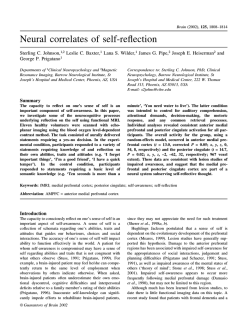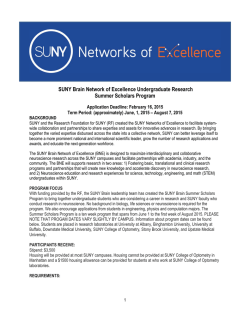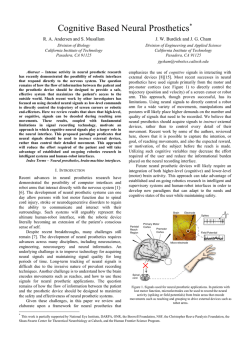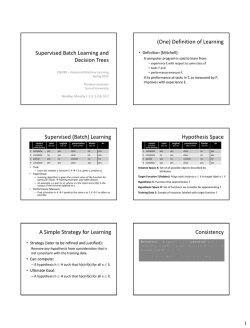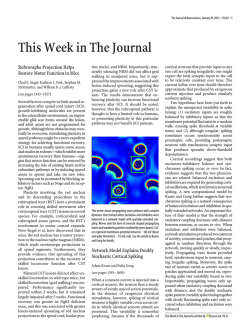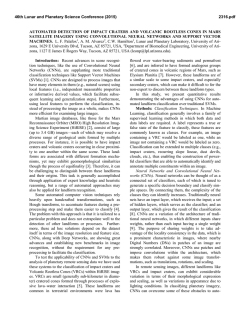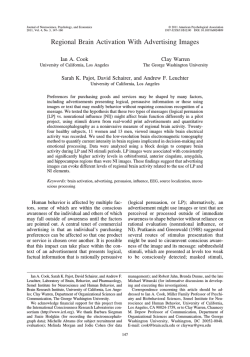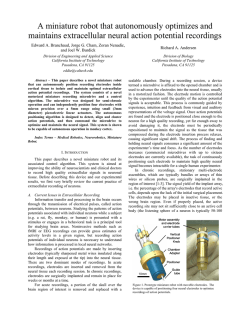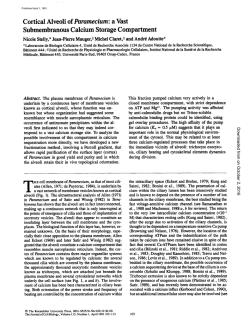
Transient hypofrontality as a mechanism for the psychological
Psychiatry Research 145 (2006) 79 – 83 www.elsevier.com/locate/psychres Hypothesis Transient hypofrontality as a mechanism for the psychological effects of exercise Arne Dietrich ⁎ Department of Social and Behavioral Sciences, American University of Beirut, Beirut, Lebanon Received 11 September 2003; received in revised form 24 January 2004; accepted 10 July 2005 Abstract Although exercise is known to promote mental health, a satisfactory understanding of the mechanism underlying this phenomenon has not yet been achieved. A new mechanism is proposed that is based on established concepts in cognitive psychology and the neurosciences as well as recent empirical work on the functional neuroanatomy of higher mental processes. Building on the fundamental principle that processing in the brain is competitive and the fact that the brain has finite metabolic resources, the transient hypofrontality hypothesis suggests that during exercise the extensive neural activation required to run motor patterns, assimilate sensory inputs, and coordinate autonomic regulation results in a concomitant transient decrease of neural activity in brain structures, such as the prefrontal cortex, that are not pertinent to performing the exercise. An exercise-induced state of frontal hypofunction can provide a coherent account of the influences of exercise on emotion and cognition. The new hypothesis is proposed primarily on the strength of its heuristic value, as it suggests several new avenues of research. © 2006 Elsevier Ireland Ltd. All rights reserved. Keywords: Anxiety; Cognition; Consciousness; Depression; Emotion; Prefrontal cortex; Stress 1. Introduction Exercise is beneficial to mood and cognition (e.g., Colcombe and Kramer, 2003; Scully et al., 1998; Tomporowski, 2003). Extensive evidence shows that in the moderate, aerobic range, exercise reduces stress, decreases anxiety, and alleviates depression (Salmon, 2001). Despite decades of research attempting to explicate a neurochemical basis for these phenomena, a sound ⁎ Department of Social and Behavioral Sciences American University of Beirut, P.O. Box 11-0236, Riad El-Solh/Beirut 1107-2020, Lebanon. Tel.: +961 1 350000x4365. E-mail address: [email protected]. mechanistic explanation is still lacking. Previous research has concentrated heavily on alterations in neurotransmitter mechanisms such as norepinephrine (Dishman, 1997), endorphins (Hoffman, 1997), serotonin (Chaouloff, 1997), and most recently endocannabinoids (Sparling et al., 2003; Dietrich and McDaniel, 2004). Bearing on this long-standing gap in the medical knowledge base, it will be shown that established concepts in cognitive psychology and the neurosciences, coupled with recent findings intimating prefrontal cortex pathology in anxiety disorders and depression, can be synthesized to formulate a new hypothesis. This surprisingly simple hypothesis, “transient hypofrontality”, is based on functional neuroanatomy and should be regarded as complementary to explanations focusing on neurotransmitter changes. 0165-1781/$ - see front matter © 2006 Elsevier Ireland Ltd. All rights reserved. doi:10.1016/j.psychres.2005.07.033 80 A. Dietrich / Psychiatry Research 145 (2006) 79–83 Importantly, this new theoretical framework yields a number of eminently testable hypotheses. 2. Exercise-induced transient hypofrontality Converging evidence from a number of techniques (133Xe washout, radioactive microsphere, and autoradiography as well as EEG, SPECT, and PET) has shown that exercise is associated with profound regional changes in motor, sensory, and autonomic regions of the brain. Marked increases in activation occur in neural structures responsible for generating the motor patterns that sustain the physical activity. In particular, the primary motor cortex, secondary motor cortices, basal ganglia, cerebellum, various midbrain and brainstem nuclei, motor pathways, and several thalamic nuclei are involved. Exercise also activates structures involved in sensory, autonomic, and memory function, particularly primary and secondary sensory cortices, sensory pathways, brainstem nuclei, hypothalamus, and the sensory thalamus. Cerebral blood flow (CBF) and local cerebral glucose utilization (LCGU) and metabolism, both indexes of the functional activity of neurons, have confirmed this pattern of neural activity in exercising non-human animals (e.g., Gross et al., 1980; Holschneider et al., 2003; Sokoloff, 1992; Vissing et al., 1996). In the most comprehensive study to date, Vissing et al. (1996) concluded that “marked exercise-induced increases in LCGU were found in cerebral gray matter structures involved in motor, sensory, and autonomic function as well as in white matter structures in the cerebellum and corpus callosum” (p. 731). Physiological data on human brain activity during exercise are remarkably sparse but consolidate, not surprisingly, the data in the animal literature. In the only PET study published to date, increased brain activation was recorded in the “primary sensory cortex, primary motor cortex, supplementary motor cortex as well as the anterior part of the cerebellum” (p. 66) in response to cycling (Christensen et al., 2000), while the only published single photon emission computed tomography study found increases in regional CBF in the supplementary motor area, medial primary sensorimotor area, striatum, visual cortex, and cerebellar vermis during walking (Fukuyama et al., 1997). There appears to be a pervasive tendency to grossly underestimate the amount of brain tissue that must be activated for the supposedly simple act of moving. It should be noted that a large part of the brain is devoted to basic sensory/perceptual processes, autonomic regulation, and motor output and must be engaged during physical activity. For instance, Vissing et al. (1996), in a study in which rats ran for 30 min on a treadmill at 85% of maximum O2 uptake, found highly significant increases in LCGU in all brain structures except in prefrontal cortex, frontal cortex, cingulum, CA3, medial nucleus of the amygdala, lateral septal area, nucleus accumbens, a few hypothalamic nuclei, median raphe nucleus, interpeduncular nucleus, nucleus of the solitary tract, and inferior olive. Taken together, these neural regions represent but a small percentage of total brain mass, confirming that physical exercise requires massive neural activation in a large number of neural structures across the entire brain. It follows that prolonged, aerobic exercise would require the sustained activation of such a large amount of neural tissue. Despite such marked regional increases, global blood flow to the brain during exercise, as well as global cerebral metabolism and oxygen uptake, remains constant (Ide and Secher, 2000; Sokoloff, 1992). During exercise, the percentage of total cardiac output to the brain is drastically reduced as blood is shunted from numerous areas, including the brain, to the muscles sustaining the workload. At maximal exercise, the brain receives approximately four times less volume per heartbeat, as compared with the resting state. This reduction is precisely offset by the overall increase in cardiac output during exercise (Astrand and Rodahl, 1986). The result of this interaction is a constant and steady perfusion rate. Thus, contrary to popular conception, there is no evidence to suggest that the brain is the recipient of additional metabolic resources during exercise (Dietrich, 2003). As a consequence of the brain's finite resources, humans possess a limited information-processing capacity. This is not only true at the bottleneck of consciousness (Broadbent, 1958), where our limited information-processing capacity is a well-established concept that forms one of the cornerstones of cognitive science, but there also exists a total cap on all neural activity, including unconscious, parallel information processing. In other words, because the brain cannot maintain activation in all neural structures at once, the activation of a given structure must come at the expense of others. Such need-based shifts of resources have been observed at a smaller scale in response to treadmill walking. Using a rat model, Holschneider et al. (2003) reported that the “significant decreases in CBF-TR noted in primary somatosensory cortex mapping the barrel field, jaw, and oral region suggests a redistribution of perfusion away from these areas during the treadmill task” (p. 929). Naturally, such costs and benefits associated with efficient information processing are a direct consequence of the principles of evolution A. Dietrich / Psychiatry Research 145 (2006) 79–83 (Edelman, 1993). Indeed, the hypothesis is consistent with the more general proposal of competitive interactions in a variety of brain systems (Desimone and Duncan, 1995; Miller and Cohen, 2001). Thus, in addition to competing for access to consciousness, brain structures are subjected to an overall informationprocessing limit due to finite metabolic resources. Evidence that sensory–motor integration tasks involving large-scale bodily movement, such as physical exercise, require massive and sustained neural activation of sensory, motor, and autonomic systems (Vissing et al., 1996), coupled with the fact that the brain operates on a fixed amount of metabolic resources (Ide and Secher, 2000), suggests that exercise must place a severe strain on the brain's limited information-processing capacity. This should result in a concomitant transient decrease in neural activity in structures that are not directly essential to the maintenance of the exercise (Dietrich, 2003). Put another way, the brain downregulates neural structures performing functions that an exercising individual can afford to disengage (Dietrich, 2004). This notion is a consequence of the fundamental principle that processing in the brain is competitive (Miller and Cohen, 2001). Depending on the type of sport, the transient hypofrontality hypothesis proposes that these areas are, first and foremost, the higher cognitive centers of the frontal lobe, and, to a lesser extent, emotional structures such as the amygdala. The transient hypofrontality hypothesis is supported by several lines of evidence. Numerous EEG studies have consistently shown that exercise is associated with alpha and theta enhancement, particularly in the frontal cortex (Boutcher and Landers, 1988; Kamp and Troost, 1978; Kubitz and Pothakos, 1997; Nybo and Nielsen, 2001; Petruzzello and Landers, 1994; Pineda and Adkisson, 1961; Youngstedt et al., 1993). An increase in alpha activity is a putative indicator of decreased brain activation (Kubitz and Pothakos, 1997; Petruzzello and Landers, 1994). For instance, Kubitz and Pothakos (1997) concluded that “exercise reliably increases EEG alpha activity” (p. 299), while Petruzzello and Landers (1994) stated that “there was a significant decrease in right frontal activation during the post-exercise period” (p. 1033). Single cell recording in exercising cats has also provided support for decreased activation in prefrontal regions. In recordings from 63 neurons in the prefrontal cortex, units associated with the control of movement showed increased activity during locomotion, while other prefrontal units decreased their discharge (Criado et al., 1997). Studies on CBF and metabolism (e.g., Gross et al., 1980; Vissing et al., 1996) have provided the strongest 81 support for the hypothesis that exercise decreases neural activity in the prefrontal cortex. As cited above, Vissing et al. (1996) found highly significant increases in LCGU in all but a few brain structures, including the prefrontal cortex. This pattern of activity is so striking that extended aerobic running could be regarded as a state of generalized brain activation with the specific exclusion of the executive system (as the other structures in this study do not constitute a large volume of neural tissue). Additional evidence for the hypothesis comes from a human study that correlated the rating of perceived exertion (RPE) with EEG activity (Nybo and Nielsen, 2001). Recording from three placements (frontal, central, and occipital cortex) during submaximal exercise, Nybo and Nielsen found that “altered EEG activity was observed in all electrode positions, and stepwise forward-regression analysis identified core temperature and a frequency index of the EEG over the frontal cortex as best indicators of RPE” (p. 2017). This finding suggests that exercise is not only associated with decreases in frontal activity but also that the degree of physical effort might be correlated with the severity of frontal deactivation. Despite this converging evidence, it is not clear how these largely physiological data that support a state of transient hypofrontality correlate with psychological function during exercise, particularly mental processes subserved by the prefrontal cortex such as working memory, sustained and directed attention, and complex social emotions. 3. Implications for mental health Because neuroimaging studies of individuals with anxiety disorders and depression show evidence of frontal lobe dysfunction, the concept of exerciseinduced transient hypofrontality suggests a new neural mechanism by which exercise might be beneficial to mental health. Briefly, in obsessive–compulsive disorder (OCD), for instance, the ventromedial prefrontal cortex (VMPFC), which has been implicated in complex emotions, exhibits widespread hypermetabolism (Baxter, 1990), while individuals with other anxiety disorders, such as posttraumatic stress disorder or phobia, show hyperactivity in the amygdala (LeDoux, 1996). Given the analytical, emotional and attentional capacities of the prefrontal cortex, the excessive activity is thought to generate a state of hyper-vigilance and hyper-awareness leading to anxiety. PET studies reveal a similar picture for depression, which is also marked by hyperactivity in the VMPFC and the amygdala (Mayberg, 1997). Conversely, the dorsolateral prefrontal 82 A. Dietrich / Psychiatry Research 145 (2006) 79–83 cortex (DLPFC), which is associated with higher cognitive functions, shows less than normal activity in depression, depriving the individual of the higher cognitive abilities that might help mitigate the negative mood. Treatment with selective serotonin reuptake inhibitors (SSRIs) results in a normalization of the malfunctioning of this complex prefrontal circuitry (Mayberg et al., 1995), pointing to an abnormal interaction between the VMPFC and the DLPFC rather than global prefrontal dysfunction (Starkstein and Robinson, 1999). Interestingly, healthy subjects asked to think sad thoughts show a similar pattern of activity (Damasio et al., 2000). Considering the similarities in brain activation, it is not surprising that OCD patients frequently develop comorbid major depression, and that the treatment of choice for both disorders is SSRIs (Starkstein and Robinson, 1999). The transient hypofrontality hypothesis proposes that exercise exerts some of its anxiolytic and antidepressant effects by inhibiting the excessive neural activity in VMPFC regions, and thus reducing the relative imbalance between VMPFC and DLPFC activity. In other words, physical exercise involving large-scale bodily motion requires massive neural activity and thus places a strain on the brain's finite neural resources, making it impossible to sustain excessive neural activity in structures, such as the prefrontal cortex and the amygdala, that are not needed at the time. As the brain must run on safe mode the very structures that appear to compute the information, engendering stress, anxiety, and negative thinking, we experience relief from life's worries due to phenomenological subtraction. In the cognitive domain, the transient hypofrontality hypothesis predicts that higher cognitive processes supported by the prefrontal cortex are selectively impaired during exercise. Using putative neuropsychological measures that are sensitive to prefrontal impairment such as the Wisconsin Card Sorting Task, the Paced Auditory Serial Addition Task, or the Stroop Test, we predicted that an individual's ability to perform tasks known to heavily recruit prefrontal circuits should be selectively impaired during endurance exercise, while tasks requiring little prefrontal activation should be unaffected. Our results showed that this is indeed the case (Dietrich and Sparling, 2004), indicating that a noncognitive task, such as running on a treadmill, can constrain recourses available for cognition. These results do not contradict other findings suggesting cognitive enhancement following exercise (Colcombe and Kramer, 2003). To illustrate, neuroimaging studies show that the pattern of neural activation associated with a particular task is unique to that task and returns to baseline levels shortly after the cessation of that task. This temporal resolution is the very basis of interpreting functional neuroimaging studies. In an EEG study using exercising cats, Ángyán and Czopf (1998) also reported that “during rest, the pre-running brain activity gradually reappeared” (p. 267). This indicates that a delay of even a few minutes would be sufficient to normalize any exercise-induced changes in neural activity and studies using a delay cannot be used to interpret congition during exercise. Thus, the transient hypofrontality hypothesis should be regarded as a limited domain hypothesis that emphasizes immediate effects of exercise on psychological function. Undoubtedly, considerably more research is needed to clarify the effects of acute exercise on brain function and how this might affect mental ability in the long term. 4. Conclusions Supportive evidence from exercise science, psychology, and neuroscience was synthesized to develop a new mechanistic explanation for the anxiolytic, antidepressant, and cognitive effects accompanying acute exercise. The transient hypofrontality hypothesis is based on neuroanatomical, physiological, and theoretical considerations and has several advantages over other approaches. First, a state of diminished activity in prefrontal regions can account for a wide variety of welldocumented cognitive and emotional changes associated with exercise. Second, unlike other theories, it can provide a coherent psychological explanation of the EEG data in humans and the single cell recording in animals, as well as the blood flow and metabolism data from both non-humans and humans. Third, it is presently the only theoretical framework that accommodates current data on the neuroanatomy of anxiety disorders and depression. Most importantly, however, the hypothesis opens unexpected avenues of research and provides a coherent account of the data on the influences of acute exercise on mental processes and psychological well-being. Although considerable evidence points to prefrontal downregulation during exercise, direct measures of transient hypofrontality are necessary to substantiate the hypothesis. References Ángyán, L., Czopf, J., 1998. Exercise-induced slow waves in the EEG of cats. Physiology and Behavior 64, 268–272. Astrand, P., Rodahl, K., 1986. Textbook of Work Physiology, 3rd ed. McGraw-Hill, New York. Baxter, L.R., 1990. Brain imaging as a tool in establishing a theory of brain pathology in obsessive–compulsive disorder. Journal of Clinical Psychiatry 5, 22–25. A. Dietrich / Psychiatry Research 145 (2006) 79–83 Boutcher, S.J., Landers, D.M., 1988. The effects of vigorous exercise on anxiety, heart rate, and alpha enhancement of runners and nonrunners. Psychophysiology 25, 696–702. Broadbent, D.A., 1958. Perception and Communication. Pergamon, New York. Chaouloff, F., 1997. The serotonin hypothesis. In: Morgan, W.P. (Ed.), Physical Activity and Mental Health. Taylor & Francis, Washington, DC, pp. 179–198. Christensen, L.O., Johannsen, P., Sinkjaer, N., Peterson, N., Pyndt, H.S., Nielsen, J.B., 2000. Cerebral activation during bicycle movements in man. Experimental Brain Research 135, 66–72. Colcombe, S., Kramer, A.F., 2003. Fitness effects on the cognitive function of older adults: a meta-analytical study. Psychological Science 14, 125–130. Criado, J.M., de la Fuente, A., Heredia, M., Riolobos, A.S., Yajeya, J., 1997. Electrophysiological study of prefrontal neurons of cats during a motor task. European Journal of Physiology 434, 91–96. Damasio, A.R., Graboweski, T.J., Bechera, A., Damasio, H., Ponto, L.L.B., Parvizi, J., Hichwa, R.D., 2000. Subcortical and cortical brain activity during the feeling of self-generated emotions. Nature Neuroscience 3, 1049–1056. Desimone, R., Duncan, J., 1995. Neural mechanisms of selective visual attention. Annual Review of Neuroscience 18, 193–222. Dietrich, A., 2003. Functional neuroanatomy of altered states of consciousness: the transient hypofrontality hypothesis. Consciousness and Cognition 12, 231–256. Dietrich, A., 2004. Neurocognitive mechanisms underlying the experience of flow. Consciousness and Cognition 13, 746–761. Dietrich, A., McDaniel, W.F., 2004. Cannabinoids and exercise. British Journal of Sports Medicine 38, 50–57. Dietrich, A., Sparling, P.B., 2004. Endurance exercise selectively impairs prefrontal-dependent cognition. Brain and Cognition 55, 516–524. Dishman, R.K., 1997. The norepinephrine hypothesis. In: Morgan, W. P. (Ed.), Physical Activity and Mental Health. Taylor & Francis, Washington, DC, pp. 199–212. Edelman, G.M., 1993. Neural Darwinism: selection and reentrant signaling in higher brain function. Neuron 10, 115–125. Fukuyama, H., Ouchi, Y., Matsuzaki, S., Nagahama, Y., Yamauchi, H., Ogawa, M., Kimura, J., Shibasaki, H., 1997. Brain functional activity during gait in normal subjects: a SPECT study. Neuroscience Letters 228, 183–186. Gross, P.M., Marcus, M.L., Heistad, D.D., 1980. Regional distribution of cerebral blood flow during exercise in dogs. Journal of Applied Physiology 48, 213–217. Hoffman, P., 1997. The endorphin hypothesis. In: Morgan, W.P. (Ed.), Physical Activity and Mental Health. Taylor & Francis, Washington, DC, pp. 161–177. Holschneider, D.P., Maarek, J.-M.I., Yang, J., Harimoto, J., Scremin, O.U., 2003. Functional brain mapping in freely moving rats during treadmill walking. Journal of Cerebral Blood Flow and Metabolism 23, 925–932. 83 Ide, K., Secher, N.H., 2000. Cerebral blood flow and metabolism during exercise. Progress in Neurobiology 61, 397–414. Kamp, A., Troost, J., 1978. EEG signs of cerebrovascular disorder, using physical exercise as a provocative method. Electroencephalography and Clinical Neurophysiology 45, 295–298. Kubitz, K.A., Pothakos, K., 1997. Does aerobic exercise decrease brain activation? Journal of Sport and Exercise Psychology 19, 291–301. LeDoux, J., 1996. The Emotional Brain. Touchstone, New York. Mayberg, H.S., 1997. Limbic-cortical dysregulation: a proposed model of depression. Journal of Neuropsychiatry and Clinical Neuroscience 9, 471–481. Mayberg, H.S., Mahurin, R.K., Brannon, K.S., 1995. Parkinson's depression: discrimination of mood-sensitive and mood-insensitive cognitive deficits using fluoxetine and FDG PET. Neurology 45, A166. Miller, E.K., Cohen, J.D., 2001. An integrative theory of prefrontal cortex function. Annual Review of Neuroscience 24, 167–202. Nybo, L., Nielsen, B., 2001. Perceived exertion is associated with an altered brain activity during exercise with progressive hyperthermia. Journal of Applied Physiology 91, 2017–2023. Petruzzello, A., Landers, D.M., 1994. State anxiety reduction and exercise: does hemispheric activation reflect such changes? Medicine and Science in Sports and Exercise 26, 1028–1035. Pineda, A., Adkisson, M.A., 1961. Electroencephalographic studies in physical fatigue. Texas Reports on Biology and Medicine 19, 332–342. Salmon, P., 2001. Effects of physical exercise on anxiety, depression, and sensitivity to stress: a unifying theory. Clinical Psychology Review 21, 33–61. Scully, D., Kremer, J., Meade, M.M., Graham, R., Dudgeon, K., 1998. Physical exercise and psychological well being: a critical review. British Journal of Sports Medicine 32, 111–120. Sokoloff, L., 1992. The brain as a chemical machine. Progress in Brain Research 94, 19–33. Sparling, P.B., Giuffrida, A., Piomelli, D., Rosskopf, L., Dietrich, A., 2003. Exercise activates the endocannabinoid system. NeuroReport 14, 2209–2211. Starkstein, S.E., Robinson, R.G., 1999. Depression and frontal lobe disorders. In: Miller, B.L., Cummings, J.L. (Eds.), The Human Frontal Lobes: Functions and Disorders. The Guilford Press, New York, pp. 247–260. Tomporowski, P.D., 2003. Effects of acute bouts of exercise on cognition. Acta Psychologica 112, 297–324. Vissing, J., Anderson, M., Diemer, N.H., 1996. Exercise-induced changes in local cerebral glucose utilization in the rat. Journal of Cerebral Blood Flow and Metabolism 16, 729–736. Youngstedt, S., Dishman, R.K., Cureton, K., Peacock, L., 1993. Does body temperature mediate anxiolytic effects of acute exercise? Journal of Applied Physiology 74, 825–831.
© Copyright 2025
